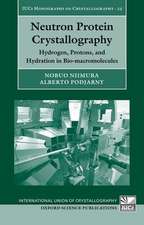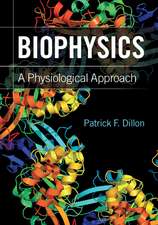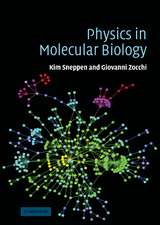Physical Models of Cell Motility: Biological and Medical Physics, Biomedical Engineering
Editat de Igor S. Aransonen Limba Engleză Hardback – 23 dec 2015
This book surveys the most recent advances in physics-inspired cell movement models. This synergetic, cross-disciplinary effort to increase the fidelity of computational algorithms will lead to a better understanding of the complex biomechanics of cell movement, and stimulate progress in research on related active matter systems, from suspensions of bacteria and synthetic swimmers to cell tissues and cytoskeleton.Cell motility and collective motion are among the most important themes in biology and statistical physics of out-of-equilibrium systems, and crucial for morphogenesis, wound healing, and immune response in eukaryotic organisms. It is also relevant for the development of effective treatment strategies for diseases such as cancer, and for the design of bioactive surfaces for cell sorting and manipulation. Substrate-based cell motility is, however, a very complex process as regulatory pathways and physical force generation mechanisms are intertwined. To understand the interplay between adhesion, force generation and motility, an abundance of computational models have been proposed in recent years, from finite element to immerse interface methods and phase field approaches.This book is primarily written for physicists, mathematical biologists and biomedical engineers working in this rapidly expanding field, and ca
n serve as supplementary reading for advanced graduate courses in biophysics and mathematical biology. The e-book incorporates experimental and computer animations illustrating various aspects of cell movement.| Toate formatele și edițiile | Preț | Express |
|---|---|---|
| Paperback (1) | 636.30 lei 6-8 săpt. | |
| Springer International Publishing – 27 mar 2019 | 636.30 lei 6-8 săpt. | |
| Hardback (1) | 642.51 lei 6-8 săpt. | |
| Springer International Publishing – 23 dec 2015 | 642.51 lei 6-8 săpt. |
Din seria Biological and Medical Physics, Biomedical Engineering
- 5%
 Preț: 1110.32 lei
Preț: 1110.32 lei - 18%
 Preț: 1006.55 lei
Preț: 1006.55 lei - 18%
 Preț: 960.78 lei
Preț: 960.78 lei - 18%
 Preț: 704.10 lei
Preț: 704.10 lei - 18%
 Preț: 967.40 lei
Preț: 967.40 lei - 18%
 Preț: 948.92 lei
Preț: 948.92 lei - 15%
 Preț: 641.71 lei
Preț: 641.71 lei - 15%
 Preț: 644.95 lei
Preț: 644.95 lei - 15%
 Preț: 665.08 lei
Preț: 665.08 lei - 18%
 Preț: 1669.16 lei
Preț: 1669.16 lei - 18%
 Preț: 941.05 lei
Preț: 941.05 lei - 18%
 Preț: 956.81 lei
Preț: 956.81 lei - 18%
 Preț: 950.21 lei
Preț: 950.21 lei - 15%
 Preț: 636.80 lei
Preț: 636.80 lei - 18%
 Preț: 947.50 lei
Preț: 947.50 lei - 15%
 Preț: 636.80 lei
Preț: 636.80 lei -
 Preț: 397.01 lei
Preț: 397.01 lei - 18%
 Preț: 1236.99 lei
Preț: 1236.99 lei - 15%
 Preț: 644.49 lei
Preț: 644.49 lei - 18%
 Preț: 946.55 lei
Preț: 946.55 lei - 15%
 Preț: 712.22 lei
Preț: 712.22 lei - 18%
 Preț: 952.89 lei
Preț: 952.89 lei - 18%
 Preț: 944.36 lei
Preț: 944.36 lei - 18%
 Preț: 1228.29 lei
Preț: 1228.29 lei - 5%
 Preț: 1422.67 lei
Preț: 1422.67 lei - 18%
 Preț: 1393.27 lei
Preț: 1393.27 lei - 15%
 Preț: 651.19 lei
Preț: 651.19 lei - 18%
 Preț: 953.65 lei
Preț: 953.65 lei - 18%
 Preț: 955.88 lei
Preț: 955.88 lei - 15%
 Preț: 644.95 lei
Preț: 644.95 lei - 5%
 Preț: 1098.48 lei
Preț: 1098.48 lei - 18%
 Preț: 959.19 lei
Preț: 959.19 lei - 15%
 Preț: 643.65 lei
Preț: 643.65 lei - 5%
 Preț: 1165.40 lei
Preț: 1165.40 lei - 5%
 Preț: 1102.67 lei
Preț: 1102.67 lei - 18%
 Preț: 952.09 lei
Preț: 952.09 lei - 18%
 Preț: 946.55 lei
Preț: 946.55 lei - 18%
 Preț: 952.09 lei
Preț: 952.09 lei - 15%
 Preț: 703.20 lei
Preț: 703.20 lei - 18%
 Preț: 953.65 lei
Preț: 953.65 lei - 5%
 Preț: 1008.41 lei
Preț: 1008.41 lei - 15%
 Preț: 644.82 lei
Preț: 644.82 lei - 18%
 Preț: 956.03 lei
Preț: 956.03 lei - 15%
 Preț: 647.40 lei
Preț: 647.40 lei
Preț: 642.51 lei
Preț vechi: 755.88 lei
-15% Nou
Puncte Express: 964
Preț estimativ în valută:
122.96€ • 127.64$ • 102.53£
122.96€ • 127.64$ • 102.53£
Carte tipărită la comandă
Livrare economică 22 martie-05 aprilie
Preluare comenzi: 021 569.72.76
Specificații
ISBN-13: 9783319244464
ISBN-10: 3319244469
Pagini: 201
Ilustrații: IX, 201 p. 61 illus., 9 illus. in color.
Dimensiuni: 155 x 235 x 13 mm
Greutate: 0.48 kg
Ediția:1st ed. 2016
Editura: Springer International Publishing
Colecția Springer
Seria Biological and Medical Physics, Biomedical Engineering
Locul publicării:Cham, Switzerland
ISBN-10: 3319244469
Pagini: 201
Ilustrații: IX, 201 p. 61 illus., 9 illus. in color.
Dimensiuni: 155 x 235 x 13 mm
Greutate: 0.48 kg
Ediția:1st ed. 2016
Editura: Springer International Publishing
Colecția Springer
Seria Biological and Medical Physics, Biomedical Engineering
Locul publicării:Cham, Switzerland
Public țintă
ResearchCuprins
Introduction.- Phase-field Description of Cell Movement.- Role of Substrate Adhesiveness.- Cytoskeletal Waves.- Chemical Signaling.- Efficiency of Cell Motion.
Textul de pe ultima copertă
This book surveys the most recent advances in physics-inspired cell movement models. This synergetic, cross-disciplinary effort to increase the fidelity of computational algorithms will lead to a better understanding of the complex biomechanics of cell movement, and stimulate progress in research on related active matter systems, from suspensions of bacteria and synthetic swimmers to cell tissues and cytoskeleton.Cell motility and collective motion are among the most important themes in biology and statistical physics of out-of-equilibrium systems, and crucial for morphogenesis, wound healing, and immune response in eukaryotic organisms. It is also relevant for the development of effective treatment strategies for diseases such as cancer, and for the design of bioactive surfaces for cell sorting and manipulation. Substrate-based cell motility is, however, a very complex process as regulatory pathways and physical force generation mechanisms are intertwined. To understand the interplay between adhesion, force generation and motility, an abundance of computational models have been proposed in recent years, from finite element to immerse interface methods and phase field approaches. This book is primarily written for physicists, mathematical biologists and biomedical engineers working in this rapidly expanding field,
and can serve as supplementary reading for advanced graduate courses in biophysics and mathematical biology. The e-book incorporates experimental and computer animations illustrating various aspects of cell movement.Caracteristici
Describes the latest computational approaches to cell movement Includes experimental and computer animations Surveys the most recent progress in substrate-based cell motility Provides a comprehensive treatment of adhesion, chemical waves, and associated phenomena














